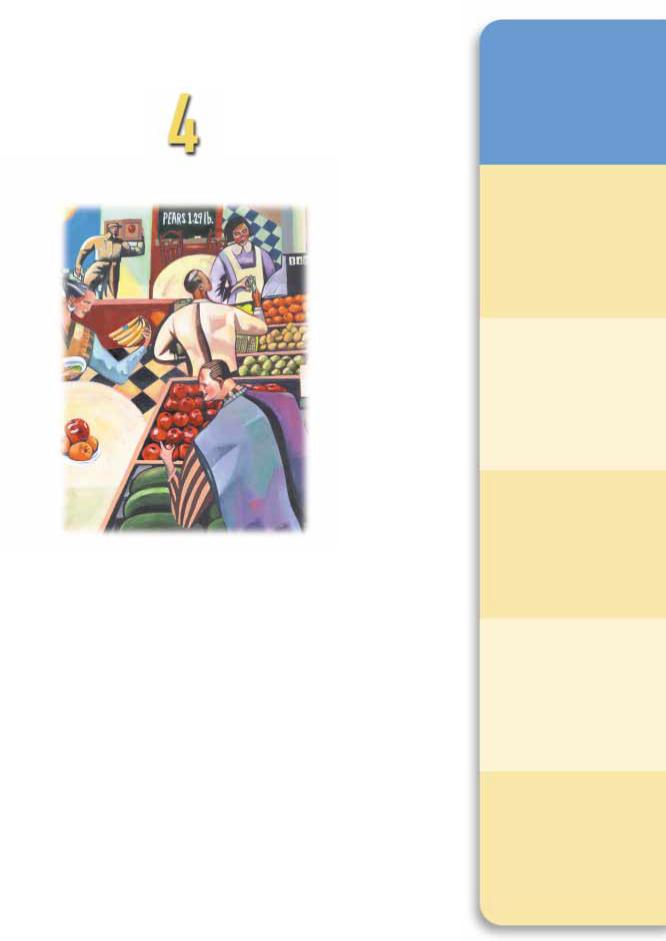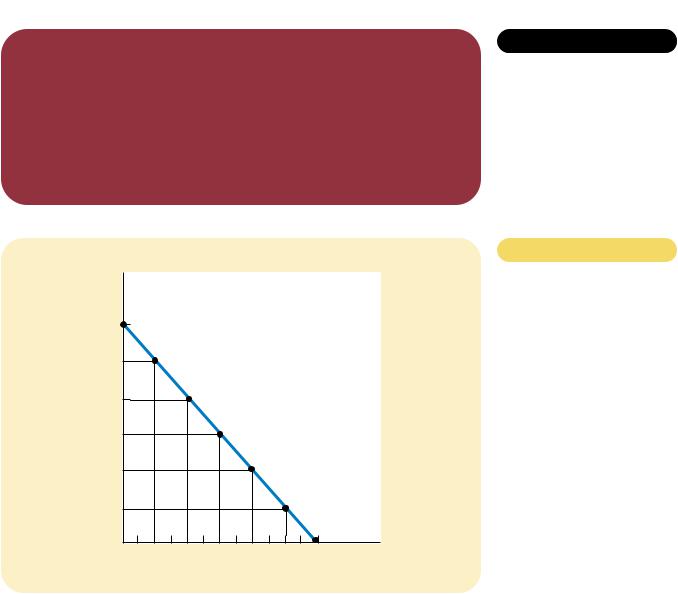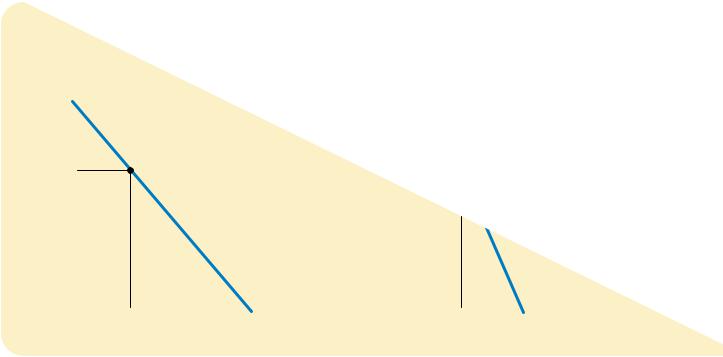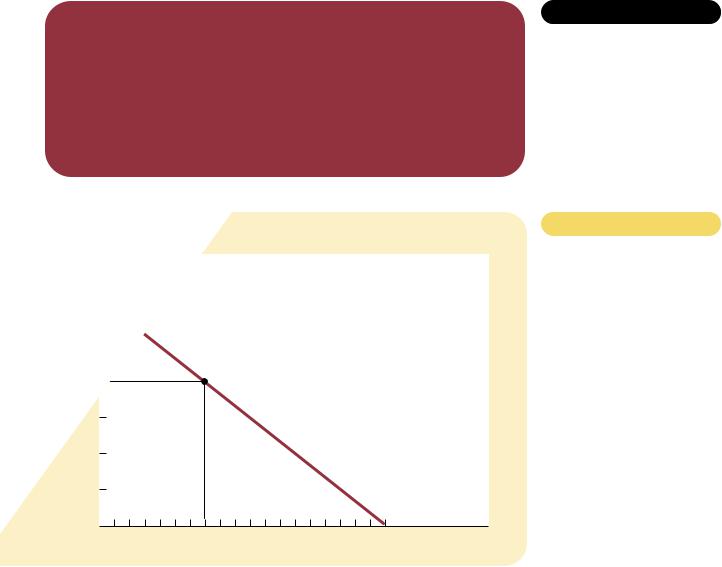
principles_of_economics_gregory_mankiw
.pdf
T H E M A R K E T F O R C E S O F
S U P P L Y A N D D E M A N D
When a cold snap hits Florida, the price of orange juice rises in supermarkets throughout the country. When the weather turns warm in New England every summer, the price of hotel rooms in the Caribbean plummets. When a war breaks out in the Middle East, the price of gasoline in the United States rises, and the price of a used Cadillac falls. What do these events have in common? They all show the workings of supply and demand.
Supply and demand are the two words that economists use most often—and for good reason. Supply and demand are the forces that make market economies work. They determine the quantity of each good produced and the price at which it is sold. If you want to know how any event or policy will affect the economy, you must think first about how it will affect supply and demand.
This chapter introduces the theory of supply and demand. It considers how buyers and sellers behave and how they interact with one another. It shows how
IN THIS CHAPTER YOU WILL . . .
Learn the natur e of a competitive market
Examine what determines the demand for a good in a competitive market
Examine what determines the supply of a good in a competitive market
See how supply and demand together set the price of a good and the quantity sold
Consider the key r ole of prices in allocating scar ce
r esour ces in market economies
65

66 |
PART TWO SUPPLY AND DEMAND I: HOW MARKETS WORK |
supply and demand determine prices in a market economy and how prices, in turn, allocate the economy’s scarce resources.
MARKETS AND COMPETITION
market
a group of buyers and sellers of a particular good or service
competitive market
a market in which there are many buyers and many sellers so that each has a negligible impact on the market price
The terms supply and demand refer to the behavior of people as they interact with one another in markets. A market is a group of buyers and sellers of a particular good or service. The buyers as a group determine the demand for the product, and the sellers as a group determine the supply of the product. Before discussing how buyers and sellers behave, let’s first consider more fully what we mean by a “market” and the various types of markets we observe in the economy.
COMPETITIVE MARKETS
Markets take many forms. Sometimes markets are highly organized, such as the markets for many agricultural commodities. In these markets, buyers and sellers meet at a specific time and place, where an auctioneer helps set prices and arrange sales.
More often, markets are less organized. For example, consider the market for ice cream in a particular town. Buyers of ice cream do not meet together at any one time. The sellers of ice cream are in different locations and offer somewhat different products. There is no auctioneer calling out the price of ice cream. Each seller posts a price for an ice-cream cone, and each buyer decides how much ice cream to buy at each store.
Even though it is not organized, the group of ice-cream buyers and ice-cream sellers forms a market. Each buyer knows that there are several sellers from which to choose, and each seller is aware that his product is similar to that offered by other sellers. The price of ice cream and the quantity of ice cream sold are not determined by any single buyer or seller. Rather, price and quantity are determined by all buyers and sellers as they interact in the marketplace.
The market for ice cream, like most markets in the economy, is highly competitive. A competitive market is a market in which there are many buyers and many sellers so that each has a negligible impact on the market price. Each seller of ice cream has limited control over the price because other sellers are offering similar products. A seller has little reason to charge less than the going price, and if he or she charges more, buyers will make their purchases elsewhere. Similarly, no single buyer of ice cream can influence the price of ice cream because each buyer purchases only a small amount.
In this chapter we examine how buyers and sellers interact in competitive markets. We see how the forces of supply and demand determine both the quantity of the good sold and its price.
COMPETITION: PERFECT AND OTHERWISE
We assume in this chapter that markets are perfectly competitive. Perfectly competitive markets are defined by two primary characteristics: (1) the goods being offered for sale are all the same, and (2) the buyers and sellers are so numerous that

CHAPTER 4 THE MARKET FORCES OF SUPPLY AND DEMAND |
67 |
no single buyer or seller can influence the market price. Because buyers and sellers in perfectly competitive markets must accept the price the market determines, they are said to be price takers.
There are some markets in which the assumption of perfect competition applies perfectly. In the wheat market, for example, there are thousands of farmers who sell wheat and millions of consumers who use wheat and wheat products. Because no single buyer or seller can influence the price of wheat, each takes the price as given.
Not all goods and services, however, are sold in perfectly competitive markets. Some markets have only one seller, and this seller sets the price. Such a seller is called a monopoly. Your local cable television company, for instance, may be a monopoly. Residents of your town probably have only one cable company from which to buy this service.
Some markets fall between the extremes of perfect competition and monopoly. One such market, called an oligopoly, has a few sellers that do not always compete aggressively. Airline routes are an example. If a route between two cities is serviced by only two or three carriers, the carriers may avoid rigorous competition to keep prices high. Another type of market is monopolistically competitive; it contains many sellers, each offering a slightly different product. Because the products are not exactly the same, each seller has some ability to set the price for its own product. An example is the software industry. Many word processing programs compete with one another for users, but every program is different from every other and has its own price.
Despite the diversity of market types we find in the world, we begin by studying perfect competition. Perfectly competitive markets are the easiest to analyze. Moreover, because some degree of competition is present in most markets, many of the lessons that we learn by studying supply and demand under perfect competition apply in more complicated markets as well.
QUICK QUIZ: What is a market? What does it mean for a market to be competitive?
DEMAND
We begin our study of markets by examining the behavior of buyers. Here we con- |
|
sider what determines the quantity demanded of any good, which is the amount |
quantity demanded |
of the good that buyers are willing and able to purchase. To focus our thinking, |
the amount of a good that buyers are |
let’s keep in mind a particular good—ice cream. |
willing and able to purchase |
WHAT DETERMINES THE QUANTITY AN
INDIVIDUAL DEMANDS?
Consider your own demand for ice cream. How do you decide how much ice cream to buy each month, and what factors affect your decision? Here are some of the answers you might give.
68 |
PART TWO SUPPLY AND DEMAND I: HOW MARKETS WORK |
law of demand
the claim that, other things equal, the quantity demanded of a good falls when the price of the good rises
normal good
a good for which, other things equal, an increase in income leads to an increase in demand
inferior good
a good for which, other things equal, an increase in income leads to a decrease in demand
substitutes
two goods for which an increase in the price of one leads to an increase in the demand for the other
complements
two goods for which an increase in the price of one leads to a decrease in the demand for the other
Price If the price of ice cream rose to $20 per scoop, you would buy less ice cream. You might buy frozen yogurt instead. If the price of ice cream fell to $0.20 per scoop, you would buy more. Because the quantity demanded falls as the price rises and rises as the price falls, we say that the quantity demanded is negatively related to the price. This relationship between price and quantity demanded is true for most goods in the economy and, in fact, is so pervasive that economists call it the law of demand: Other things equal, when the price of a good rises, the quantity demanded of the good falls.
Income What would happen to your demand for ice cream if you lost your job one summer? Most likely, it would fall. A lower income means that you have less to spend in total, so you would have to spend less on some—and probably most— goods. If the demand for a good falls when income falls, the good is called a normal good.
Not all goods are normal goods. If the demand for a good rises when income falls, the good is called an inferior good. An example of an inferior good might be bus rides. As your income falls, you are less likely to buy a car or take a cab, and more likely to ride the bus.
Prices of Related Goods Suppose that the price of frozen yogurt falls. The law of demand says that you will buy more frozen yogurt. At the same time, you will probably buy less ice cream. Because ice cream and frozen yogurt are both cold, sweet, creamy desserts, they satisfy similar desires. When a fall in the price of one good reduces the demand for another good, the two goods are called substitutes. Substitutes are often pairs of goods that are used in place of each other, such as hot dogs and hamburgers, sweaters and sweatshirts, and movie tickets and video rentals.
Now suppose that the price of hot fudge falls. According to the law of demand, you will buy more hot fudge. Yet, in this case, you will buy more ice cream as well, because ice cream and hot fudge are often used together. When a fall in the price of one good raises the demand for another good, the two goods are called complements. Complements are often pairs of goods that are used together, such as gasoline and automobiles, computers and software, and skis and ski lift tickets.
Tastes The most obvious determinant of your demand is your tastes. If you like ice cream, you buy more of it. Economists normally do not try to explain people’s tastes because tastes are based on historical and psychological forces that are beyond the realm of economics. Economists do, however, examine what happens when tastes change.
Expectations Your expectations about the future may affect your demand for a good or service today. For example, if you expect to earn a higher income next month, you may be more willing to spend some of your current savings buying ice cream. As another example, if you expect the price of ice cream to fall tomorrow, you may be less willing to buy an ice-cream cone at today’s price.

CHAPTER 4 THE MARKET FORCES OF SUPPLY AND DEMAND |
69 |
THE DEMAND SCHEDULE AND THE DEMAND CURVE
We have seen that many variables determine the quantity of ice cream a person demands. Imagine that we hold all these variables constant except one—the price. Let’s consider how the price affects the quantity of ice cream demanded.
Table 4-1 shows how many ice-cream cones Catherine buys each month at different prices of ice cream. If ice cream is free, Catherine eats 12 cones. At $0.50 per cone, Catherine buys 10 cones. As the price rises further, she buys fewer and fewer cones. When the price reaches $3.00, Catherine doesn’t buy any ice cream at all. Table 4-1 is a demand schedule, a table that shows the relationship between the price of a good and the quantity demanded. (Economists use the term schedule because the table, with its parallel columns of numbers, resembles a train schedule.)
Figure 4-1 graphs the numbers in Table 4-1. By convention, the price of ice cream is on the vertical axis, and the quantity of ice cream demanded is on the
PRICE OF ICE-CREAM CONE |
QUANTITY OF CONES DEMANDED |
|
|
$0.00 |
12 |
0.50 |
10 |
1.00 |
8 |
1.50 |
6 |
2.00 |
4 |
2.50 |
2 |
3.00 |
0 |
Price of
Ice-Cream
Cone
$3.00
2.50
2.00
1.50
1.00
0.50
0 1 2 3 4 5 6 7 8 9 10 11 12 Quantity of
Ice-Cream Cones
demand schedule
a table that shows the relationship between the price of a good and the quantity demanded
Table 4-1
CATHERINE’S DEMAND
SCHEDULE. The demand schedule shows the quantity demanded at each price.
Figur e 4-1
CATHERINE’S DEMAND CURVE.
This demand curve, which graphs the demand schedule in Table 4-1, shows how the quantity demanded of the good changes as its price varies. Because a lower price increases the quantity demanded, the demand curve slopes downward.

70 |
PART TWO SUPPLY AND DEMAND I: HOW MARKETS WORK |
demand cur ve
a graph of the relationship between the price of a good and the quantity demanded
ceteris paribus
a Latin phrase, translated as “other things being equal,” used as a reminder that all variables other than the ones being studied are assumed to be constant
horizontal axis. The downward-sloping line relating price and quantity demanded is called the demand curve.
CETERIS PARIBUS
Whenever you see a demand curve, remember that it is drawn holding many things constant. Catherine’s demand curve in Figure 4-1 shows what happens to the quantity of ice cream Catherine demands when only the price of ice cream varies. The curve is drawn assuming that Catherine’s income, tastes, expectations, and the prices of related products are not changing.
Economists use the term ceteris paribus to signify that all the relevant variables, except those being studied at that moment, are held constant. The Latin phrase literally means “other things being equal.” The demand curve slopes downward because, ceteris paribus, lower prices mean a greater quantity demanded.
Although the term ceteris paribus refers to a hypothetical situation in which some variables are assumed to be constant, in the real world many things change at the same time. For this reason, when we use the tools of supply and demand to analyze events or policies, it is important to keep in mind what is being held constant and what is not.
MARKET DEMAND VERSUS INDIVIDUAL DEMAND
So far we have talked about an individual’s demand for a product. To analyze how markets work, we need to determine the market demand, which is the sum of all the individual demands for a particular good or service.
|
|
|
|
|
|
|
|
|
Catherine’s Demand |
|
|
Nicholas’s Demand |
||||||||||||||||||||
Price of |
|
|
|
|
|
|
|
|
|
|
|
|
|
|
|
|
Price of |
|
|
|
|
|
|
|
|
|
|
|
|
|
|
|
|
|
|
|
|
|
|
|
|
|
|
|
|
|
|
|
|
|
|
|
|
|
|
|
|
|
|
|
|
|
|||
|
|
|
|
|
|
|
|
|
|
|
|
|
|
|
|
|
||||||||||||||||
Ice-Cream |
|
|
|
|
|
|
|
|
|
|
|
|
|
|
|
|
Ice-Cream |
|
|
|
|
|
|
|
|
|
|
|
|
|
|
|
Cone |
|
|
|
|
|
|
|
|
|
|
|
|
|
|
|
|
Cone |
|
|
|
|
|
|
|
|
|
|
|
|
|
|
|
$3.00 |
|
|
|
|
|
|
|
|
|
|
|
|
|
|
|
|
$3.00 |
|
|
|
|
|
|
|
|
|
|
|
|
|
|
|
|
|
|
|
|
|
|
|
|
|
|
|
|
|
|
|
|
|
|
|
|
|
|
|
|
|
|
|
|
|
|
||
2.50 |
|
|
|
|
|
|
|
|
|
|
|
|
|
|
|
|
2.50 |
|
|
|
|
|
|
|
|
|
|
|
|
|
|
|
|
|
|
|
|
|
|
|
|
|
|
|
|
|
|
|
|
|
|
|
|
|
|
|
|
|
|
|
|
|
|
||
2.00 |
|
|
|
|
|
|
|
|
|
|
|
|
|
|
|
|
2.00 |
|
|
|
|
|
|
|
|
|
|
|
|
|
|
|
|
|
|
|
|
|
|
|
|
|
|
|
|
|
|
|
|
|
|
|
|
|
|
|
|
|
|
|
|
|
|
||
1.50 |
|
|
|
|
|
|
|
|
|
|
|
|
|
|
|
|
1.50 |
|
|
|
|
|
|
|
|
|
|
|
|
|
|
|
|
|
|
|
|
|
|
|
|
|
|
|
|
|
|
|
|
|
|
|
|
|
|
|
|
|
|
|
|
|
|
||
1.00 |
|
|
|
|
|
|
|
|
|
|
|
|
|
|
|
|
1.00 |
|
|
|
|
|
|
|
|
|
|
|
|
|
|
|
|
|
|
|
|
|
|
|
|
|
|
|
|
|
|
|
|
|
|
|
|
|
|
|
|
|
|
|
|
|
|
||
0.50 |
|
|
|
|
|
|
|
|
|
|
|
|
|
|
|
|
0.50 |
|
|
|
|
|
|
|
|
|
|
|
|
|
|
|
|
|
|
|
|
|
|
|
|
|
|
|
|
|
|
|
|
|
|
|
|
|
|
|
|
|
|
|
|
|
|
||
|
|
|
|
|
|
|
|
|
|
|
|
|
|
|
|
|
|
|
|
|
|
|
|
|
|
|
|
|
|
|
|
|
|
|
|
|
|
|
|
|
|
|
|
|
|
|
|
|
|
|
|
|
|
|
|
|
|
|
|
|
|
|
|
|
|
0 1 2 3 4 5 6 7 8 9 10 11 12 Quantity of |
0 1 2 3 4 |
5 6 7 8 9 10 11 12 Quantity of |
||||||||||||||||||||||||||||||
|
|
|
|
|
|
|
|
|
|
|
|
|
|
|
Ice-Cream Cones |
|
|
|
|
|
|
|
|
|
|
|
|
|
|
Ice-Cream Cones |
||

CHAPTER 4 THE MARKET FORCES OF SUPPLY AND DEMAND |
71 |
Table 4-2 shows the demand schedules for ice cream of two individuals— Catherine and Nicholas. At any price, Catherine’s demand schedule tells us how much ice cream she buys, and Nicholas’s demand schedule tells us how much ice cream he buys. The market demand is the sum of the two individual demands.
Because market demand is derived from individual demands, it depends on all those factors that determine the demand of individual buyers. Thus, market demand depends on buyers’ incomes, tastes, expectations, and the prices of related goods. It also depends on the number of buyers. (If Peter, another consumer of ice cream, were to join Catherine and Nicholas, the quantity demanded in the market would be higher at every price.) The demand schedules in Table 4-2 show what happens to quantity demanded as the price varies while all the other variables that determine quantity demanded are held constant.
Figure 4-2 shows the demand curves that correspond to these demand schedules. Notice that we sum the individual demand curves horizontally to obtain the
PRICE OF ICE-CREAM CONE |
CATHERINE |
|
NICHOLAS |
|
MARKET |
|
|
|
|
|
|
$0.00 |
12 |
|
7 |
|
19 |
0.50 |
10 |
|
6 |
|
16 |
1.00 |
8 |
|
5 |
|
13 |
1.50 |
6 |
|
4 |
|
10 |
2.00 |
4 |
|
3 |
|
7 |
2.50 |
2 |
|
2 |
|
4 |
3.00 |
0 |
|
1 |
|
1 |
|
Market Demand |
Price of |
|
Ice-Cream |
|
Cone |
|
$3.00
2.50
2.00
1.50
1.00
0.50
0 1 2 3 4 5 6 7 8 9 10 11 12 13 14 15 16 17 18 19 |
Quantity of |
( 4 3) |
Ice-Cream Cones |
Table 4-2
INDIVIDUAL AND MARKET
DEMAND SCHEDULES. The
quantity demanded in a market is the sum of the quantities demanded by all the buyers.

72 |
PART TWO SUPPLY AND DEMAND I: HOW MARKETS WORK |
market demand curve. That is, to find the total quantity demanded at any price, we add the individual quantities found on the horizontal axis of the individual demand curves. Because we are interested in analyzing how markets work, we will work most often with the market demand curve. The market demand curve shows how the total quantity demanded of a good varies as the price of the good varies.
SHIFTS IN THE DEMAND CURVE
Suppose that the American Medical Association suddenly announces a new discovery: People who regularly eat ice cream live longer, healthier lives. How does this announcement affect the market for ice cream? The discovery changes people’s tastes and raises the demand for ice cream. At any given price, buyers now want to purchase a larger quantity of ice cream, and the demand curve for ice cream shifts to the right.
Whenever any determinant of demand changes, other than the good’s price, the demand curve shifts. As Figure 4-3 shows, any change that increases the quantity demanded at every price shifts the demand curve to the right. Similarly, any change that reduces the quantity demanded at every price shifts the demand curve to the left.
Table 4-3 lists the variables that determine the quantity demanded in a market and how a change in the variable affects the demand curve. Notice that price plays a special role in this table. Because price is on the vertical axis when we graph a demand curve, a change in price does not shift the curve but represents a movement along it. By contrast, when there is a change in income, the prices of related goods, tastes, expectations, or the number of buyers, the quantity demanded at each price changes; this is represented by a shift in the demand curve.
Figur e 4-3
SHIFTS IN THE DEMAND CURVE.
Any change that raises the quantity that buyers wish to purchase at a given price shifts the demand curve to the right. Any change that lowers the quantity that buyers wish to purchase at a given price shifts the demand curve to the left.
Price of
Ice-Cream
Cone
Increase in demand
Decrease in demand
Demand curve, D2
Demand curve, D1
Demand curve, D3
0 |
Quantity of |
|
Ice-Cream Cones |

CHAPTER 4 THE MARKET FORCES OF SUPPLY AND DEMAND |
73 |
VARIABLES THAT AFFECT |
|
QUANTITY DEMANDED |
A CHANGE IN THIS VARIABLE . . . |
|
|
Price |
Represents a movement along the demand curve |
Income |
Shifts the demand curve |
Prices of related goods |
Shifts the demand curve |
Tastes |
Shifts the demand curve |
Expectations |
Shifts the demand curve |
Number of buyers |
Shifts the demand curve |
In summary, the demand curve shows what happens to the quantity demanded of a good when its price varies, holding constant all other determinants of quantity demanded. When one of these other determinants changes, the demand curve shifts.
Table 4-3
THE DETERMINANTS OF
QUANTITY DEMANDED. This
table lists the variables that can influence the quantity demanded in a market. Notice the special role that price plays: A change in the price represents a movement along the demand curve, whereas a change in one of the other variables shifts the demand curve.
CASE STUDY TWO WAYS TO REDUCE THE QUANTITY OF SMOKING DEMANDED
Public policymakers often want to reduce the amount that people smoke. There are two ways that policy can attempt to achieve this goal.
One way to reduce smoking is to shift the demand curve for cigarettes and other tobacco products. Public service announcements, mandatory health warnings on cigarette packages, and the prohibition of cigarette advertising on television are all policies aimed at reducing the quantity of cigarettes demanded at any given price. If successful, these policies shift the demand curve for cigarettes to the left, as in panel (a) of Figure 4-4.
Alternatively, policymakers can try to raise the price of cigarettes. If the government taxes the manufacture of cigarettes, for example, cigarette companies pass much of this tax on to consumers in the form of higher prices. A higher price encourages smokers to reduce the numbers of cigarettes they smoke. In this case, the reduced amount of smoking does not represent a shift in the demand curve. Instead, it represents a movement along the same demand curve to a point with a higher price and lower quantity, as in panel (b) of Figure 4-4.
How much does the amount of smoking respond to changes in the price of cigarettes? Economists have attempted to answer this question by studying what happens when the tax on cigarettes changes. They have found that a 10 percent increase in the price causes a 4 percent reduction in the quantity demanded. Teenagers are found to be especially sensitive to the price of cigarettes: A 10 percent increase in the price causes a 12 percent drop in teenage smoking.
A related question is how the price of cigarettes affects the demand for illicit drugs, such as marijuana. Opponents of cigarette taxes often argue that tobacco and marijuana are substitutes, so that high cigarette prices encourage marijuana use. By contrast, many experts on substance abuse view tobacco as a “gateway drug” leading the young to experiment with other harmful substances. Most studies of the data are consistent with this view: They find that lower cigarette prices are associated with greater use of marijuana. In other words, tobacco and marijuana appear to be complements rather than substitutes.
WHAT IS THE BEST WAY TO STOP THIS?

74 |
PART TWO SUPPLY AND DEMAND I: HOW MARKETS WORK |
Figur e 4-4
SHIFTS IN THE DEMAND CURVE
VERSUS MOVEMENTS ALONG THE
DEMAND CURVE. If warnings on cigarette packages convince smokers to smoke less, the demand curve for cigarettes shifts to the left. In panel (a), the demand curve shifts from D1 to D2. At a price of $2 per pack, the quantity demanded falls from 20 to 10 cigarettes per day, as
reflected by the shift from point A to point B. By contrast, if a tax raises the price of cigarettes, the demand curve does not shift. Instead, we observe a movement to a different point on the demand curve. In panel (b), when the price rises from $2 to $4, the quantity demanded falls from 20 to 12 cigarettes per day, as reflected by the movement from point A to point C.
Price of
Cigarettes,
per Pack
$2.00
0
Price of
Cigarettes,
per Pack
$4.00
2.00
0
(a) A Shift in the Demand Curve
A policy to discourage smoking shifts the demand curve to the left.
B A
D1
D2
10 |
|
20 |
Number of Cigarettes |
|
|||
|
|
|
Smoked per Day |
(b) A Movement along the Demand Curve
A tax that raises the price of cigarettes results in a movement along the demand curve.
C |
A
|
|
|
D1 |
12 |
|
20 |
Number of Cigarettes |
|
|||
|
|
|
Smoked per Day |
QUICK QUIZ: List the determinants of the quantity of pizza you demand.Make up an example of a demand schedule for pizza, and graph the implied demand curve. Give an example of something that would shift this demand curve. Would a change in the price of pizza shift this demand curve?
